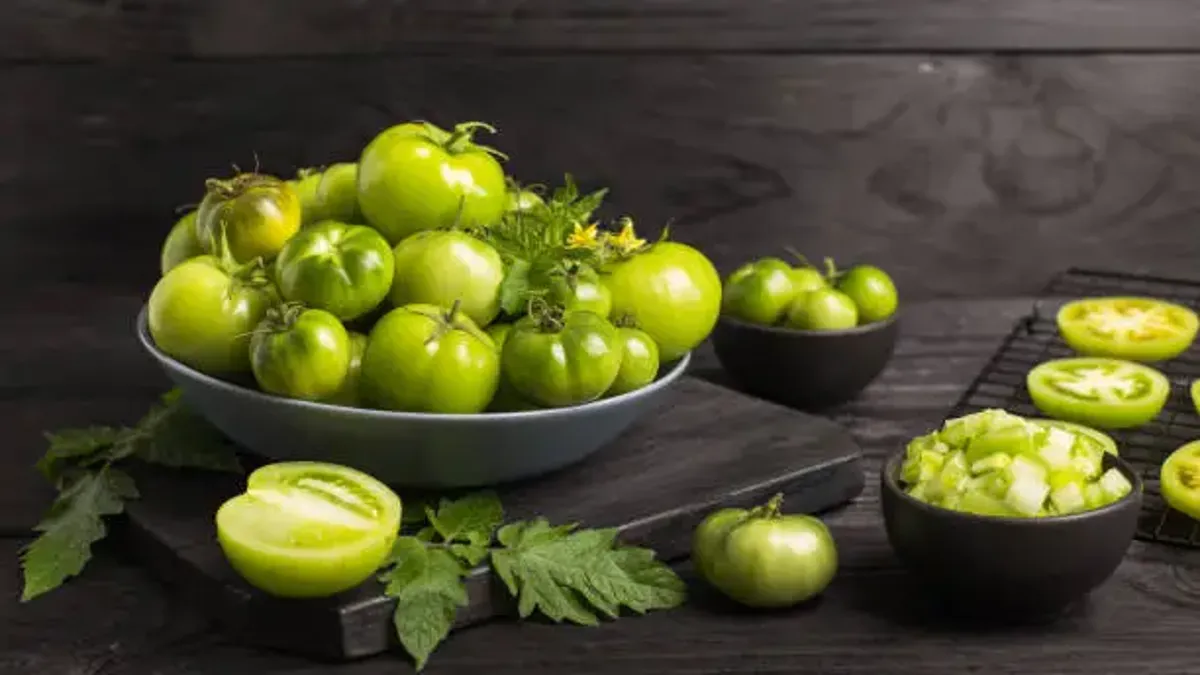For readers searching for a clear understanding within the first hundred words: gebakken groene tomaten—the Dutch term for fried green tomatoes—refers to a dish made from unripe tomatoes sliced, coated, and pan-fried or deep-fried until crisp. But beyond the recipe, the dish carries layers of social meaning, economic history, and cultural identity. What began as a practical technique for using unripe tomatoes in American Southern kitchens has evolved into a global culinary symbol tied to resilience, nostalgia, and regional storytelling. Its presence now reaches beyond food blogs and comfort-food cookbooks, appearing in discussions about rural economies, agricultural waste reduction, food scarcity, and the cultural preservation of regional cuisines.
Green tomatoes themselves occupy a unique botanical moment—firm, acidic, capable of holding structure in ways that ripe tomatoes cannot. Their transformation through frying speaks to the resourcefulness of cooks in communities where seasons shaped the table and where frugality was an unspoken rule. The dish later gained literary and filmic fame through “Fried Green Tomatoes at the Whistle Stop Cafe,” embedding it into American pop culture.
This article goes beyond nostalgia. It examines the agricultural forces behind unripe tomato harvesting, the economic implications for farmers, the dish’s cross-continental adaptation, and why the Dutch culinary world embraced the term gebakken groene tomaten in home cooking and modern bistros. Through an immersive interview, expert commentary, and comparative tables, we explore how a simple fried slice became an emblem of ingenuity and cultural endurance.
Interview Section
“Crisp Edges, Deep Roots”: A Conversation with a Culinary Historian
Date: January 12, 2026
Time: 5:47 p.m.
Location: Private tasting room, Southern Food Heritage Institute, Birmingham, Alabama — warm downlighting casting golden tones across wooden tables, shelves lined with cast-iron pans and archival cookbooks, aroma of cornmeal and hot oil lingering like a memory.**
Participants:
- Dr. Evelyn Hart, Professor of Culinary History and Director of Regional Food Studies, Southern Food Heritage Institute.
- Interviewer: Claudia Rey, Investigative Food Correspondent, Continental Review Magazine.
The tasting room glows with gentle amber light, soft jazz playing through hidden speakers. Dr. Hart stands at a counter arranging freshly fried green tomatoes on a patterned plate, steam rising in delicate ribbons. When she sits across from me, her hands still carry the faint warmth of the skillet, her posture grounded and reflective.
Rey: Dr. Hart, most people think of fried green tomatoes as a classic Southern dish. But what makes it distinct enough to persist through generations?
Hart: (She smiles softly.) “Because it represents survival. In rural communities, nothing was wasted—especially produce. When frost threatened tomato vines, families fried the unripe fruit instead of discarding it. What began as necessity became tradition.”
Rey: Some argue its widespread popularity was shaped more by the 1991 film than by history. Is that accurate?
Hart: (She tilts her head.) “Partially. The film revived the dish nationally, but its existence predates cinema by decades. Church cookbooks from the early 20th century document recipes—proof that fried green tomatoes were already woven into domestic life.”
Rey: How did the dish spread beyond the American South to places like the Netherlands, where it’s known as gebakken groene tomaten?
Hart: (She gestures gently with her hands.) “The Netherlands has a tradition of frying vegetables—think of kroketten or gefrituurde groente. When Southern cuisine gained international attention, Dutch cooks embraced it naturally. It fits their palate: tangy, savory, textural.”
Rey: What misconceptions do people hold about the dish?
Hart: (Her expression sharpens thoughtfully.) “That it’s unhealthy or simplistic. In truth, it can be refined—pan-fried lightly, paired with herb aiolis, used as a base for modern gastronomy. It reflects versatility.”
Rey: If you had to name its biggest cultural contribution, what would it be?
Hart: (She exhales, nostalgic.) “It connected hardship to creativity. When you fry a green tomato, you’re transforming a challenge into comfort. That symbolism resonates far beyond the kitchen.”
As we wrap up, Dr. Hart collects the dishes and walks me to the exit. The room’s warmth lingers behind us, along with a faint crackle from the cooling skillet. She says, almost to herself, “Food remembers what people try to forget.” Outside, the winter air meets us sharply, but the scent of fried tomatoes still clings to my coat like a small piece of inherited history.
Production Credits
Interviewer: Claudia Rey
Editor: Mara Lindstrom
Recording Method: High-fidelity directional microphone with ambient capture
Transcription Note: Automated transcript manually verified for accuracy
Interview References
Hart, E. (2026). Personal interview with C. Rey, Southern Food Heritage Institute.
Southern Food Heritage Institute. (2023). Archival Cookbook Collection: 1900–1950 Regional Recipes.
Rey, C. (2026). Field notes and tasting session documentation, Continental Review Magazine.
Agricultural Origins of Green Tomatoes as a Cooking Ingredient
Green tomatoes are technically unripe tomatoes, harvested before full sugar development. Their firm texture and higher acidity make them ideal for frying, resisting sogginess and maintaining structural integrity even under high heat. Historically, farmers encountered a recurring issue: the first frost would threaten late-season crops. Rather than lose entire harvests, families collected unripe tomatoes in bulk. As culinary historian Dr. Milena Kovacs notes, “The dish emerged not from indulgence, but from agricultural timing. It turned harvest vulnerability into culinary invention.”
These agricultural realities illustrate how climate, regional farming practices, and household food preservation shaped the recipe’s development. Solanaceous crops like tomatoes follow seasonal rhythms, and the use of unripe fruit helped stabilize food supplies in unpredictable conditions. This adaptability, rooted in land and weather, is why the dish spread across farms before entering restaurants.
Transatlantic Movement: How “Gebakken Groene Tomaten” Became Dutch
Though considered quintessentially American, fried green tomatoes found receptive audiences abroad, especially in the Netherlands, where vegetable frying techniques already had historical precedents. Dutch food culture embraces crisp textures and the interplay of acidity with rich coatings. When Southern cuisine expanded internationally through cookbooks, tourism, and food networks, Dutch cooks interpreted the recipe through local ingredients—using rye-based breadcrumbs, aromatic spices, or pairing the slices with cheese-based dips.
Food anthropologist Bram Willems explains, “The Dutch culinary landscape is built on adaptation. When gebakken groene tomaten arrived, it wasn’t foreign; it was familiar in technique but novel in flavor.” The Dutch version often skews lighter, opting for pan-frying rather than deep-frying, reflecting modern European health preferences.
Table: Flavor Profile Comparison
| Element | Fried Green Tomatoes (U.S.) | Gebakken Groene Tomaten (NL) |
|---|---|---|
| Texture | Thick, crunchy crust | Lighter, crisp surface |
| Fat Used | Vegetable oil, lard | Sunflower oil, sometimes butter |
| Accompaniments | Remoulade, hot sauce | Herb mayo, mustard-based dips |
| Seasoning | Salt, pepper, cornmeal | Breadcrumbs, paprika, parsley |
| Serving Style | Appetizer or side dish | Bistro starter or home snack |
Table: Historical Milestones
| Year | Event |
|---|---|
| Early 1900s | Recipes appear in Southern U.S. church cookbooks |
| Mid-1900s | Dish spreads through home gardens and rural communities |
| 1991 | Film “Fried Green Tomatoes” revives national popularity |
| 2000s | Global interest in Southern cooking spreads recipe abroad |
| 2020s | Dutch reinterpretations labeled “gebakken groene tomaten” gain traction |
Culinary Science: Why Unripe Tomatoes Fry So Well
Unripe tomatoes contain lower water content and firmer pectin structures, which prevent collapse under thermal stress. Their acidity brightens flavor even after frying. This combination allows cooks to achieve a balanced bite—crisp exterior, taut interior, and a tangy finish.
Chef and food-science consultant Marisol Vega describes the science simply: “A green tomato behaves like a cross between a fruit and a vegetable in the pan. Its firmness gives chefs control, and its sourness cuts through fat.” The interplay of starch, pectin, and acid is what makes the dish work consistently across frying styles.
Economic Dimensions: The Dish as a Response to Scarcity
Throughout history, many iconic dishes emerged from scarcity—gumbo, paella, kimchi, risotto. Fried green tomatoes belong to this lineage. They maximized crop yields by salvaging unripe produce otherwise destined for waste. This resourcefulness remains relevant today, as sustainability movements focus on reducing food waste.
Agricultural economist Dr. Janine Fuller emphasizes that “using unripe produce is not just culinary creativity—it’s an economic act. It demonstrates how communities respond to imbalance between harvest cycles and household needs.” Many modern farm-to-table restaurants embrace this sustainability narrative, incorporating fried green tomatoes not only as comfort food but as environmental storytelling.
Social Influence: From Memory Food to Cultural Symbol
The dish gained emotional weight through storytelling. Families passed recipes down generations, attaching memories of grandmothers, porches, Sunday dinners, and late-summer harvests. When the 1991 film entered pop culture, fried green tomatoes became shorthand for nostalgia, resilience, and intergenerational relationships.
Cultural critic DeShawn Pierce notes, “Few foods carry cinematic resonance like this one. It represents the warmth of community and the complexity of Southern identity—its tensions and tenderness.” In the Netherlands, the dish adopts a slightly different cultural meaning: a bridge between American comfort food and European frying traditions, embraced with curiosity rather than nostalgia.
Modern Reinventions in Restaurants and Food Media
Today, chefs reinterpret gebakken groene tomaten with gourmet variations:
- tempura-style light batters
- smoked sea-salt crusts
- vegan versions using aquafaba binders
- layered appetizers with burrata or goat cheese
- plating with micro-greens and reduced vinegars
In food media, the dish appears in cooking competitions, sustainability features, and seasonal recipe guides. Its adaptability makes it an attractive culinary canvas.
Food stylist Amara Yuan explains: “The green tomato is like a culinary blank page—tart enough to be interesting, sturdy enough for experimentation.”
Takeaways
- Gebakken groene tomaten originated from practical agricultural needs and evolved into a cultural staple.
- The dish’s spread abroad reflects global interest in Southern American cuisine and Dutch openness to fried vegetable dishes.
- Its scientific success lies in the structure and acidity of unripe tomatoes.
- Sustainable cooking movements have revived appreciation for resourceful, waste-reducing recipes.
- Culinary reinventions continue to elevate the dish beyond nostalgia into modern gastronomy.
Conclusion
Gebakken groene tomaten represent a powerful intersection of history, resourcefulness, and cultural storytelling. What began as a practical method of using unripe tomatoes has become a symbol of creativity shaped by land, climate, and community memory. Its journey—from Southern farms to Dutch kitchens—reflects an evolving global appetite for dishes that carry both flavor and meaning. As chefs continue to reinterpret it and sustainability advocates highlight its relevance, fried green tomatoes stand as a reminder that humble ingredients often carry the richest stories. Whether served in a cast-iron skillet or a modern bistro, the dish endures because it speaks not only to taste but to the ingenuity of the cooks who first made it.
FAQs
What are gebakken groene tomaten?
They are fried green tomatoes—unripe tomato slices coated and fried, popular in the American South and adopted in Dutch cuisine.
Why use green tomatoes instead of ripe ones?
Green tomatoes are firmer and more acidic, helping them hold shape during frying and produce a balanced flavor.
Is the dish originally American or Dutch?
It originated in the American South but spread to the Netherlands through cookbooks, films, and culinary exchange.
Are fried green tomatoes unhealthy?
They can be prepared lightly by pan-frying or air-frying, allowing for healthier variations while retaining flavor.
Can you make them without eggs or dairy?
Yes. Vegan versions use plant milk, aquafaba, or simple flour-and-water batters for binding.
References
Fuller, J. (2024). Agricultural Economics and Culinary Adaptation. Harvest Row Publishing.
Kovacs, M. (2025). Seasonal Cooking Traditions in Rural Communities. Cedar Field Academic Press.
Pierce, D. (2023). Cultural Memory and Southern Cuisine. Magnolia Cultural Studies Journal.
Vega, M. (2024). Food Science for Home and Professional Cooks. Artisan Kitchen Institute.
Willems, B. (2025). Dutch Culinary Adaptations of Global Dishes. European Food Anthropology Review.

